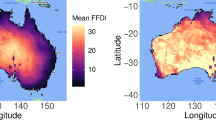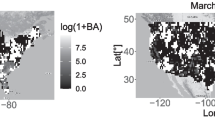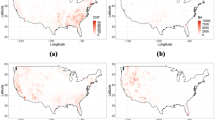Abstract
In this paper we propose a procedure to estimate the distribution of wildfire frequency and severity using the wildfire data measured by month during 1993–2015. To this end, a spatial quantile autoregressive model (SQAR) is applied to the data with an aid of extreme value theory. Using the proposed method we are able to predict the distributional behavior of the data and identify the hidden structures beyond their mean structures. In addition, abundant interpretations are available with a regression-based model. We provide the estimated results from the wildfire data, including significant explanatory variables and some meaningful interpretations.












Similar content being viewed by others
Code availability
Codes for generating the results in the paper are available in https://github.com/JongminLee-stat/SQAR.
Data Availability
The datasets generated during and/or analysed during the current study are available from Optiz (2022) or from the corresponding author on reasonable request.
References
Casson, E., Coles, S.: Spatial regression models for extremes. Extremes 1(4), 449–468 (1999)
Chernozhukov, V., Hansen, C.: An iv model of quantile treatment effects. Econometrica 73(1), 245–261 (2005)
Chernozhukov, V., Hansen, C.: Instrumental quantile regression inference for structural and treatment effect models. J. Econ. 132(2), 491–525 (2006)
Chernozhukov, V., Fernández-Val, I., Galichon, A.: Quantile and probability curves without crossing. Econometrica 78(3), 1093–1125 (2010)
Cooley, D., Nychka, D., Naveau, P.: Bayesian spatial modeling of extreme precipitation return levels. J. Am. Stat.Assoc. 102(479), 824–840 (2007)
Davison, A.C., Padoan, S.A., Ribatet, M.: Statistical modeling of spatial extremes. Stat. Sci. 27(2), 161–186 (2012)
De Haan, L., Ferreira, A., Ferreira, A.: Extreme value theory: an introduction, vol. 21. Springer (2006)
Dennison, P.E., Brewer, S.C., Arnold, J.D., et al.: Large wildfire trends in the Western United States, 1984–2011. Geophys. Res. Lett. 41(8), 2928–2933 (2014)
Diaz, J.M.: Economic impacts of wildfire. Southern Fire Exchange 498, 2012–7 (2012)
Duncan, D.T., Piras, G., Dunn, E.C., et al.: The built environment and depressive symptoms among urban youth: a spatial regression study. Spat. Spatiotemporal Epidemiol. 5, 11–25 (2013)
Einmahl, J.H., deHaan, L., Zhou, C.: Statistics of heteroscedastic extremes. J. R. Stat. Soc. Ser. B (Stat Methodol) 31–51 (2016)
Ferreira, A., De Haan, L.: The generalized pareto process; with a view towards application and simulation. Bernoulli 20(4), 1717–1737 (2014)
Genton, M.G., Butry, D.T., Gumpertz, M.L., et al.: Spatio-temporal analysis of wildfire ignitions in the St Johns River Water Management District, Florida. Int. J. Wildland Fire 15(1), 87–97 (2006)
Goulard, M., Laurent, T., Thomas-Agnan, C.: About predictions in spatial autoregressive models: Optimal and almost optimal strategies. Spat. Econ. Anal. 12(2–3), 304–325 (2017)
Heffernan, J.E., Tawn, J.A.: A conditional approach for multivariate extreme values (with discussion). J. R. Stat. Soc. Ser. B (Stat Methodol.) 66(3), 497–546 (2004)
Hijmans, R.J., Williams, E., Vennes, C.: Package ‘geosphere’. Cran.R-project.org (2017). Accessed 1 May 2021
Hill, B.M.: A simple general approach to inference about the tail of a distribution. Ann. Stat. 3(5), 1163–1174 (1975)
Huser, R., Wadsworth, J.L.: Modeling spatial processes with unknown extremal dependence class. J. Am. Stat. Assoc. 114(525), 434–444 (2019)
Huser, R., Wadsworth, J.L.: Advances in statistical modeling of spatial extremes. Wiley Interdiscip. Rev. Comput. Stat. e1537 (2020)
Joseph, M.B., Rossi, M.W., Mietkiewicz, N.P., etal,: Spatiotemporal prediction of wildfire size extremes with Bayesian finite sample maxima. Ecol. Appl. 29(6), e01898 (2019)
Kanaroglou, P.S., Adams, M.D., De Luca, P.F., et al.: Estimation of sulfur dioxide air pollution concentrations with a spatial autoregressive model. Atmos. Environ. 79, 421–427 (2013)
Kelejian, H.H., Prucha, I.R.: A generalized spatial two-stage least squares procedure for estimating a spatial autoregressive model with autoregressive disturbances. J. Real Estate Financ. Econ. 17(1), 99–121 (1998)
Kelejian, H.H., Prucha, I.R.: A generalized moments estimator for the autoregressive parameter in a spatial model. Int. Econ. Rev. 40(2), 509–533 (1999)
Kim, J., Park, S., Kwon, J., et al.: Estimation of spatio-temporal extreme distribution using a quantile factor model. Extremes 24(1), 177–195 (2021)
Kim, T.H., Muller, C.: Two-stage quantile regression when the first stage is based on quantile regression. Economet. J. 7(1), 218–231 (2004)
Koenker, R.: Quantile Regression. Cambridge University Press (2005)
Koenker, R., Portnoy, S., Ng, P.T., et al.: Package ‘quantreg’. Cran.R-project.org (2018). Accessed 1 May 2021
Koh, J., Pimont, F., Dupuy, J.L., et al.: Spatio-temporal wildfire modeling through point processes with moderate and extreme marks. Preprint at http://arxiv.org/abs/2105.08004 (2021)
Kostov, P.: A spatial quantile regression hedonic model of agricultural land prices. Spat. Econ. Anal. 4(1), 53–72 (2009)
Kostov, P.: Model boosting for spatial weighting matrix selection in spatial lag models. Environ. Plann. B. Plann. Des. 37(3), 533–549 (2010)
Liao, W.C., Wang, X.: Hedonic house prices and spatial quantile regression. J. Hous. Econ. 21(1), 16–27 (2012)
Liu, S., Hite, D.: Measuring the effect of green space on property value: an application of the hedonic spatial quantile regression. Tech. rep (2013)
Lome-Hurtado, A., Touza-Montero, J., White, P.C.: Environmental injustice in Mexico City: a spatial quantile approach. Exposure and Health 12(2), 265–279 (2020)
Machado, J.A.F., Silva, J.S.: Quantiles for counts. J. Am. Stat. Assoc. 100(472), 1226–1237 (2005)
McMillen, D.P.: Quantile regression for spatial data. Springer Science & Business Media (2012)
Moritz, S., Bartz-Beielstein, T.: imputeTS: time series missing value imputation in R. R Journal 9(1), 207 (2017)
Nason, G.: Wavelet methods in statistics with R. Springer Science & Business Media (2008)
Opitz, T.: Editorial: Eva 2021 data competition on spatio-temporal prediction of wildfire activity in the United States. Extremes (2022)
Pace, R.K., Barry, R., Clapp, J.M., et al.: Spatiotemporal autoregressive models of neighborhood effects. J. Real Estate Financ. Econ. 17(1), 15–33 (1998)
Pyne, S.J.: Introduction to wildland fire. Fire Management in the United States. John Wiley & Sons (1984)
Que, X., Ma, X., Ma, C., et al.: A spatiotemporal weighted regression model (STWR v1. 0) for analyzing local nonstationarity in space and time. Geosci. Model Dev. 13(12), 6149–6164 (2020)
Rootzén, H., Tajvidi, N.: Multivariate generalized Pareto distributions. Bernoulli 12(5), 917–930 (2006)
Sawadogo, B., Barro, D.: Modeling space-time trends and dependence in extreme precipitations of Burkina Faso by the approach of the peaks-over-threshold. Preprint at http://arxiv.org/abs/2105.05548 (2021)
Su, L., Yang, Z.: Instrumental variable quantile estimation of spatial autoregressive models. Research Collection School of Economics (2011)
Sun, H., Tu, Y., Yu, S.M.: A spatio-temporal autoregressive model for multi-unit residential market analysis. J. Real Estate Financ. Econ. 31(2), 155–187 (2005)
Tawn, J., Shooter, R., Towe, R., et al.: Modelling spatial extreme events with environmental applications. Spatial Statistics 28, 39–58 (2018)
Turkman, K.F., Turkman, A., Pereira, J.: Asymptotic models and inference for extremes of spatio-temporal data. Extremes 13(4), 375–397 (2010)
Wang, H.J., Li, D., He, X.: Estimation of high conditional quantiles for heavy-tailed distributions. J. Am. Stat. Assoc. 107(500), 1453–1464 (2012)
Weissman, I.: Estimation of parameters and large quantiles based on the k largest observations. J. Am. Stat. Assoc. 73(364), 812–815 (1978)
Zhang, Z., Huser, R., Opitz, T., et al.: Modeling spatial extremes using normal mean-variance mixtures. Preprint at http://arxiv.org/abs/2105.05314 (2021)
Zietz, J., Zietz, E.N., Sirmans, G.S.: Determinants of house prices: a quantile regression approach. J. Real Estate Financ. Econ. 37(4), 317–333 (2008)
Acknowledgements
The authors would like to thank Thomas Opitz for organizing the data competition for the 12th International conference on Extreme Value Analysis 2021. We also thank Hee-Seok Oh for encouraging us to participate in the data competition and for discussion. We moreover thank anonymous two referees and an Associate Editor for insightful comments.
Funding
Jongmin Lee is a beneficiary of an individual grant from CAINS supported by a KIAS Individual Grant (AP090201) via the Center for AI and Natural Sciences at Korea Institute for Advanced Study (KIAS). This work was supported by the National Research Foundation of Korea (NRF) grant funded by the Korea government (MSIT) (No. NRF-2020R1A4A1018207, NRF-2022R1C1C2003747).
Author information
Authors and Affiliations
Corresponding author
Ethics declarations
Conflicts of interest
Jongmin Lee, Joonpyo Kim, Joonho Shin, Seongjin Cho, Seongmin Kim and Kyoungjae Lee declare that they have no conflicts of interest.
Additional information
Publisher’s Note
Springer Nature remains neutral with regard to jurisdictional claims in published maps and institutional affiliations.
Supplementary Information
Below is the link to the electronic supplementary material.
Rights and permissions
Springer Nature or its licensor (e.g. a society or other partner) holds exclusive rights to this article under a publishing agreement with the author(s) or other rightsholder(s); author self-archiving of the accepted manuscript version of this article is solely governed by the terms of such publishing agreement and applicable law.
About this article
Cite this article
Lee, J., Kim, J., Shin, J. et al. Analysis of wildfires and their extremes via spatial quantile autoregressive model. Extremes 26, 353–379 (2023). https://doi.org/10.1007/s10687-023-00462-0
Received:
Revised:
Accepted:
Published:
Issue Date:
DOI: https://doi.org/10.1007/s10687-023-00462-0




